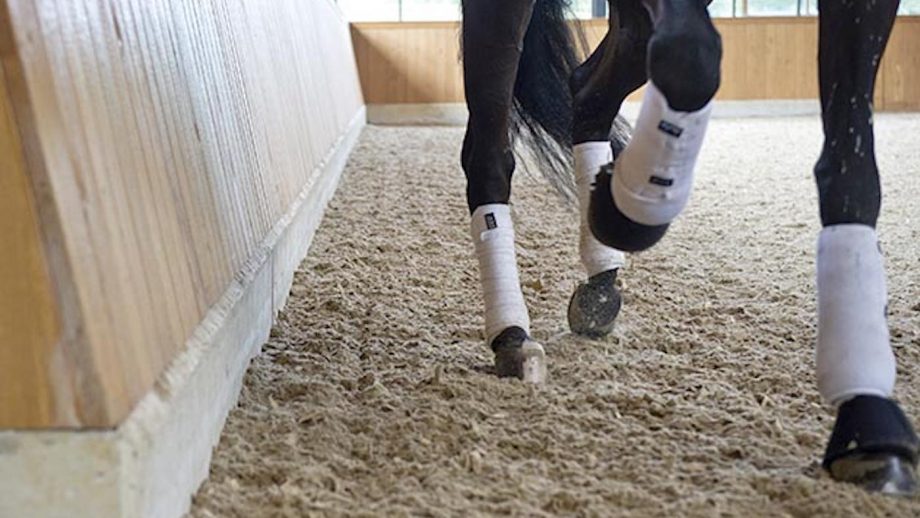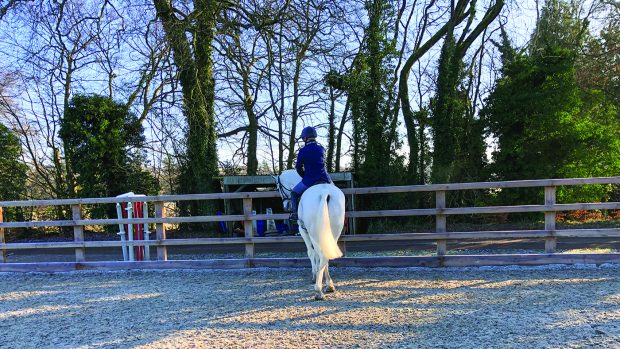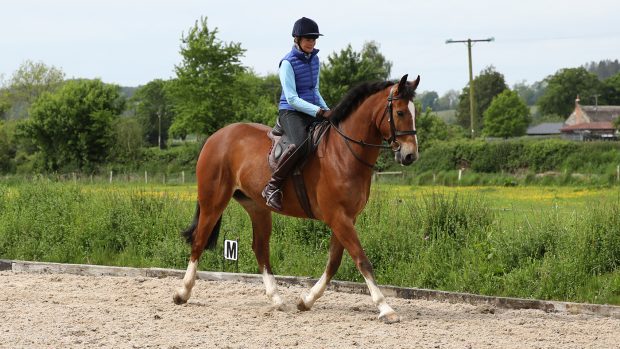Most riders find learning how to ride sitting trot a challenge — how on earth are you supposed to look elegant and effortless while being a positive influence on your horse? Most importantly, how do you avoid bouncing all over the place, making the experience uncomfortable for both of you? Well the good news is that every rider can improve how well they sit to the trot – if they are prepared to work at it.
Successful young dressage rider Joanna Thurman-Baker (pictured), who has competed up to grand prix and represented Britain team at the young rider European championships riding Highcliffe Apollo, recommends:
1. Lunge lessons — These are so invaluable. You can learn to have an independent seat and how to sit and flow with the horse’s movement.
2. Pilates — Learning how to engage your core muscles off the horse will help strengthen them and allow you to switch these muscles on when you are in sitting trot.
3. Take away your stirrups — This may seem like torture at the time, but when you have the stirrups back, you will appreciate how easy sitting trot is with them. Your stirrups should be no longer then just below your ankle bone.
4. Most importantly, don’t try sitting trot until your horse is ready. They need to be soft in their back and accepting of the rider’s seat.
Learn how to transform your mindset with Horse & Hound’s new online rider confidence course. Our experts’ positive psychology will give you the knowledge to transform your skills.
A good seat will not only help you improve your sitting trot, but it will help all aspects of your riding, so time spent on this will pay dividends in the long term. Sitting in balance with equal weight in both seat bones is one of the priorities.
“Lift one foot one centimetre off the ground and you will have 100% of your weight on the other foot,” says Dickie Waygood, one of Britain’s most successful military event riders, World Class performance director and eventing performance manager.
The point Dickie is making is that what appears to be a tiny shift in weight can completely change your balance and therefore the horse’s balance – “with immediate effect”.
How to ride sitting trot: avoiding tension
Dickie and top showing rider Katie Jerram-Hunnable warn of the dangers of having any tension anywhere in your body, which can affect your seat and in turn, make sitting trot difficult and uncomfortable.
Katie says: “No part of your leg should be tight. Once you start gripping, you start working against the horse, and then you have tension. If you are stiff in your back, you are creating a block. If your arms are stiff, you are blocking, then the horse starts pulling, which makes you pivot and lose balance. And your hands should never be tight on the rein.”
The cause of tension is often fatigue. Dickie explains why it is critical to recognise it in yourself as well as the horse: “When you are fatigued, and also when the horse is tired, muscles become tense and tight. Then you lose relaxation – physically and mentally – you and your horse. Relaxation equals suppleness, and suppleness is one of the scales of training.”
The solution is simple: “If you feel yourself starting to tire, take a short break. Tension only has a negative effect; it is a downward spiral.”
Top tips
- Katie advises checking the basics if you are having problems with your seat: “Make sure your saddle fits your horse correctly. The saddle needs to work with you and not against you and the horse”.
- Consider seeking advice from a strength-and-conditioning coach who specialises in helping riders, so you work on your weaknesses without causing muscle imbalances.
- If you only ride one horse a day, Dickie recommends finding exercises to do off the horse to work on your weaknesses, “so you don’t waste time while you’re on the horse”.
- Katie suggests Pilates as a good starting point if you need to build core strength: “Pilates makes you understand your core. Your core strength is what helps you get the best out of your horse.”
- You can start off by just trying a few strides of sitting trot at a time, and as soon as your horse’s way of going is affected, return to rising trot. Over time you can gradually build up the amount of sitting trot you can manage as a partnership.
- It isn’t always possible, but being lunged without stirrups and reins can help identify problems. Katie says: “If things are not going well, I strip everything back. When I’m lungeing someone without stirrups and reins, I can see whether they have an independent seat and whether their hands are too strong. I make sure they can do rising trot and transitions without reins.”
- If you can’t or don’t have access to lunge lessons, then a mechanical horse can be a useful option for honing your technique in a way that doesn’t impact a real horse.
- Dickie suggests an easy and cheap way of checking whether you are sitting straight: “Put tape on the back of your jacket, in a cross, and get someone on the ground to check which way you tip. We’re like horses – one-sided. Recognise that and work on it.”
- Dickie warns of one of the most common ways to lose balance: “When you look down, you automatically put yourself out of balance. It is really important to look ahead.”
- Take regular, short breaks so neither you or your horse suffer muscle fatigue.
You might also be interested in:

What is medium trot, and what are the benefits for your horse?

The half halt: a simple guide on how to ride it

How to ride in a double bridle

Subscribe to Horse & Hound magazine today – and enjoy unlimited website access all year round
Horse & Hound magazine, out every Thursday, is packed with all the latest news and reports, as well as interviews, specials, nostalgia, vet and training advice. Find how you can enjoy the magazine delivered to your door every week, plus options to upgrade your subscription to access our online service that brings you breaking news and reports as well as other benefits.




